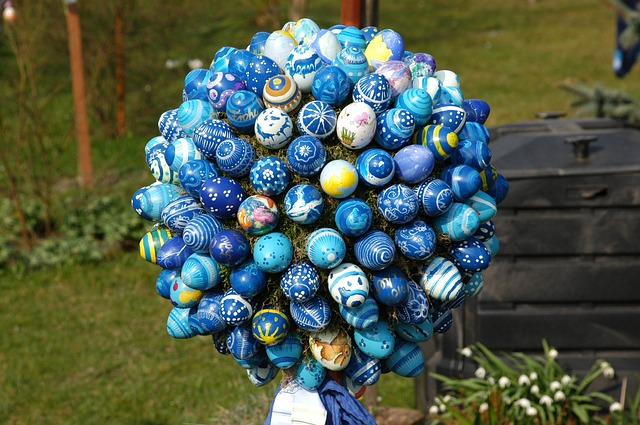Ostereierbaum to osterbrunnen: Extreme Easter egg decorating in Germany
 Friday, February 28, 2020 at 11:50AM
Friday, February 28, 2020 at 11:50AM  An Easter egg topiary that is likely part of an Osterbrunnen display. Photo: Maria-Anne RothSometimes an idea consumes you.
An Easter egg topiary that is likely part of an Osterbrunnen display. Photo: Maria-Anne RothSometimes an idea consumes you.
While looking for Easter ideas for the current issue of At Home, I happened upon an image of the globe shape at left. It was so pretty and uniformly covered by assorted blue Easter eggs.
I could not figure out if it was a perfectly pruned shrub or a ball of some penetrable material, covered in sheet moss and pierced by some sort of rods onto which eggs had been mounted.
I had a strong sense that it was the latter. It would be difficult, I figured to place the eggs so uniformly in a shrub.
Then I saw a similar image with two topiaries. It was marked "Easter Well." A Google search informed me that Easter wells are elaborately decorated frameworks covered in greenery and erected in certain parts of Germany. There, they are called Osterbrunnen, and they can incorporate egg in garlands, eggs on strings, eggs on sticks and eggs attached to a variety of surfaces. (I learned all this from YouTube.) I searched on and off for days for images and then videos online. I found numerous tourist videos that show that the structures aren't always erected around a well. I have to admit that the overall look of many of the displays doesn't appeal to me, but those shown in two or the three videos below are lovely exceptions. All the videos are in German, but it's possible to follow the visuals even if you don't speak the language.
But what I wanted to was know how to make the topiary-like egg tree (searches for which brought me to the amazingly gorgeous Easter egg tree of Volker Kraft). Ultimately, I started searching for videos with German words, and, eventually, I came across the videos that follow.
The first shows a group of women who last April were painting hollowed egg shells for an Osterbrunnen in the Bavarian town Diepersdorf. Next, they pulled out crates of eggs that had already been painted and started the work of stringing them into garlands using extremely long needles.
I thought such garlands would be a fun craft to share in the current issue, but we ran out of time and space. Plus, the video still did not give me any idea how the topiary tree was made.
I kept searching with German words I came across, using Google Translate for those that were not familiar. Kugel aus handbemalten Ostereiern, which translates as "ball of hand-painted Easter eggs" taught me that eirern is the plural form of eirer (egg). I used those words to search with Osterbrunnen and got closer. The video that follows gives insight into the decorating process, although using artificial eggs. And it shows that eggs on sticks are indeed used. (In photos from other displays, real blown eggs can be seen glued to skewers or threaded through their blowing holes onto heavy-gauge wire, curled or with a bead at the end.)
What I love most about these videos is people coming together to make something spectacular. Individual egg-adorned elements -- wreaths, topiaries, garlands and numerous clusters of hanging eggs -- are highly inspiring and can be adapted to decorate around the house and garden. The video below shows a group in Pörnbach, another Bavarian town, erecting the framework for their church Osterbrunnen and then decorating it. It's an appealing one that's like a massive floral arrangement of arches covered in evergreen, boxwood cuttings and Easter eggs. This video is a bit longer at 13 minutes, but if you're into this, it's worth the time to watch.
 Kimberly L. Jackson | Comments Off |
Kimberly L. Jackson | Comments Off | 